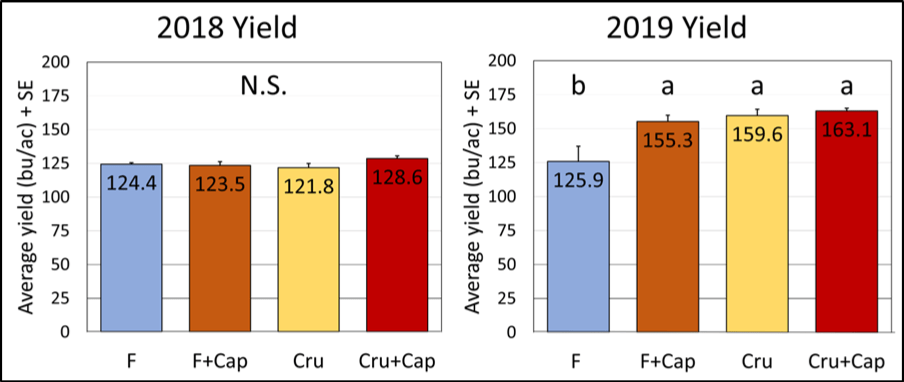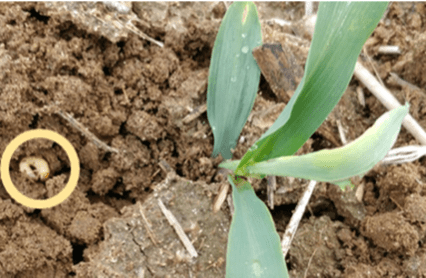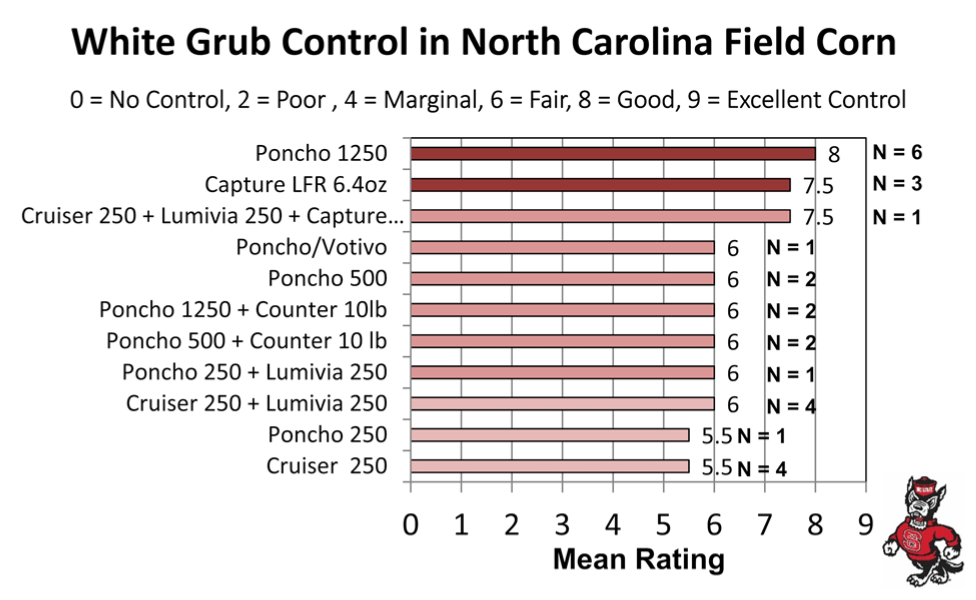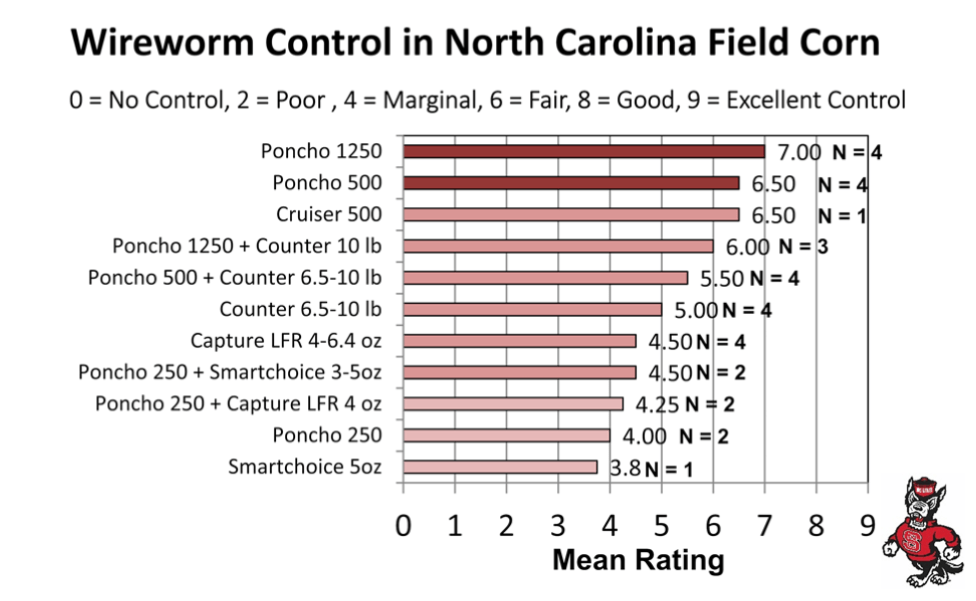Maria Cramer, Edwin Afful, Galen Dively, and Kelly Hamby
Department of Entomology, University of Maryland

Background: Multiple insecticide options are available for early-season corn pest management, including neonicotinoid seed treatments (NSTs) and in-furrow pyrethroids such as Capture LFR®. In addition, many Bt corn hybrids provide protection against seedling foliar pests such as cutworm and armyworm. Given that almost all corn seed is treated with neonicotinoid seed treatments (NSTs), Capture LFR® may not provide any additional protection.
Methods: In this study we compared four treatments: fungicide seed treatments alone; Capture LFR® (active ingredient: bifenthrin) applied in the planting furrow with the fungicide seed treatment; Cruiser Maxx® 250, an NST (active ingredient: thiamethoxam), which includes a fungicide; and Capture LFR® + Cruiser Maxx® 250 together. We evaluated the amount of soil and foliar pest damage after emergence. Yield was measured at harvest.
Preliminary results: Our results suggest that when wireworm pressure is high, Capture LFR® and Cruiser Maxx® 250 protect against damage and significantly increase yields. Neither treatment is superior, so we recommend using only one, and only in fields where pest pressure is known to be high. As most corn seed already contains NSTs, use of Capture LFR® at planting is unlikely to be warranted.

Background: Capture LFR®, an in-furrow pyrethroid product, is marketed for control of early-season corn pests, including soil pests such as white grub and wireworm and above-ground pests such as cutworm and armyworm. However, the insect pest management systems already adopted in corn may provide sufficient protection. Most corn seeds are treated with NSTs, which provide seedlings with systemic protection from many soil and above-ground pests. Additionally, most Bt corn hybrids express proteins with efficacy against cutworm and armyworm in the seedling stage, although they do not affect soil pests. Unlike NSTs and Bt traits, pyrethroids are not systemic and do not provide protection beyond the soil area to which they are applied.
While in-furrow applications of bifenthrin (the active ingredient in Capture LFR®) can effectively reduce wireworm damage in potatoes1 and provides white grub control in field corn2,3, it does not consistently increase yield in corn3 or soybeans4. Yield benefits are likely to be seen only where there is known soil pest pressure. Meanwhile, preventative applications of pyrethroids have been linked to declines in natural enemies 5,6, including carabid beetles, which are important predators of slugs.
Objectives: Our objectives were to determine whether in-furrow applications of Capture LFR® (bifenthrin) provided 1) protection against soil pests, 2) protection against seedling pests, and 3) yield benefits compared with fungicide alone, Cruiser Maxx® 250, or combined with Cruiser Maxx® 250.
Methods: This study was conducted in 2018 and 2019 at the University of Maryland research farm in Beltsville, MD. We planted 4 replicate plots of a standard Bt field corn hybrid, TA 758-22DP (VT Double Pro insect control) in 2018 and LC1488 VT2P (SmartStax RIB complete insect control) in 2019 at 29,999 seeds per acre. Plots were planted late in 2018 (June 18) but on time in 2019 (May 20). Standard agronomic growing practices for the region were used. We compared the following four treatments, applied at planting:
| No in-furrow application | In-furrow Capture LFR®
Applied at 13.6 fl oz/ac |
|
| Fungicide seed treatment | Fungicide (F) seed treatment alone
2018: Maxim Quattro® 2019: Vibrance Cinco® |
Fungicide +
Capture LFR® (F + Cap)
|
| Cruiser Maxx® 250 | Cruiser Maxx® 250
(Cru) |
Cruiser Maxx® 250 + Capture LFR® (Cru +Cap) |
We sampled plants 24 days after planting in 2018, and 18 days after planting in 2019. In 2018, we recorded the number of stunted plants (indicating potential soil pest damage), and in 2019, we dug up stunted plants and recorded those for which soil pest damage could be confirmed. In both years, we assessed rates of above-ground feeding by pests such as cutworm and armyworm.
Wireworm (left) and characteristic above-ground symptoms of wireworm feeding (right). Note wilted center leaf.Results: Soil Pests. In 2018 there was no difference in the percent stunted plants between treatments (Figure 1), with less than 5% stunting in all treatments. This low level of pest damage may have been due to the late planting date, which could have avoided peak soil pest pressure. In 2019, all of the insecticide treatments had significantly lower soil pest damage than the fungicide control (Figure 1). Combining Capture LFR® with Cruiser Maxx® 250 was not more effective than Cruiser Maxx® 250 alone, but was more effective than Capture LFR® alone, suggesting that treatments involving Cruiser Maxx® 250 are somewhat more effective against the soil pests at this farm. In both years, plots were located in a field with a history of wireworms; however, damage was only observed in 2019. In a field without pest pressure, such as we saw in 2018, these treatments did not improve plant stand.
Foliar pests. In both 2018 and 2019, rates of foliar damage were extremely low (below 5% of plants) in all treatments and there were no differences between treatments.
Yield. In 2018, there were no yield differences between the treatments (Figure 2). Overall, we had low yields in 2018, likely a result of the late planting date. In 2019, all of the insecticide treatments had significantly higher yields than the fungicide control, with no differences between any of the insecticide treatments (Figure 2). Combining Capture LFR® with Cruiser Maxx® 250 did not increase yield.


Conclusions: In 2018 and 2019 we did not see sufficient foliar pest pressure to justify an insecticide application. This may be due to effective control by Bt proteins in the corn hybrids and/or low foliar pest pressure.
In a field with established wireworm pressure, all three insecticide treatments reduced soil pest damage and improved yield relative to a fungicide only control in the 2019 field season. While there were differences in pest damage levels between the different insecticide treatments, no one treatment provided superior yield benefits. Because nearly all corn seed is treated with NSTs like Cruiser Maxx® 250, additional applications of Capture LFR® may not be necessary. Preventative applications increase costs and present risks to beneficial insects without providing yield benefits. Additionally, soil pest pressure tends to be low throughout Maryland. We sampled untreated corn at five locations across Maryland in 2019 and found on average less than 3% soil pest damage. Unless a field has a known history of wireworms or white grubs, we do not recommend using at-planting insecticides.
Acknowledgements and Funding. This project was funded in both years by the Maryland Grain Producers Utilization Board. We appreciate the help provided by Rachel Sanford, Madison Tewey, Eric Crandell, Gabriel Aborisade, and Kevin Conover.
Sources
- Langdon, K. W., Colee, J. & Abney, M. R. Observing the effect of soil-applied insecticides on wireworm (coleoptera: Elateridae) behavior and mortality using radiographic imaging. J. Econ. Entomol. 111, 1724–1731 (2018).
- Afful, E., Illahi, N. & Hamby, K. Agronomy News. 10, 2–4 (2019).
- Reisig, D. & Goldsworthy, E. Efficacy of Insecticidal Seed Treatments and Bifenthrin In-Furrow for Annual White Grub, 2016. Arthropod Manag. Tests 43, 1–2 (2017).
- Koch, R. L., Rich, W. A., Potter, B. D. & Hammond, R. B. Effects on soybean of prophylactic in-furrow application of insecticide and fertilizer in Minnesota and Ohio. Plant Heal. Prog. 17, 59–63 (2016).
- Douglas, M. R. & Tooker, J. F. Meta-analysis reveals that seed-applied neonicotinoids and pyrethroids have similar negative effects on abundance of arthropod natural enemies. PeerJ 1–26 (2016). doi:10.7717/peerj.2776
- Funayama, K. Influence of pest control pressure on occurrence of ground beetles (Coleoptera: Carabidae) in apple orchards. Appl. Entomol. Zool. 46, 103–110 (2011).





